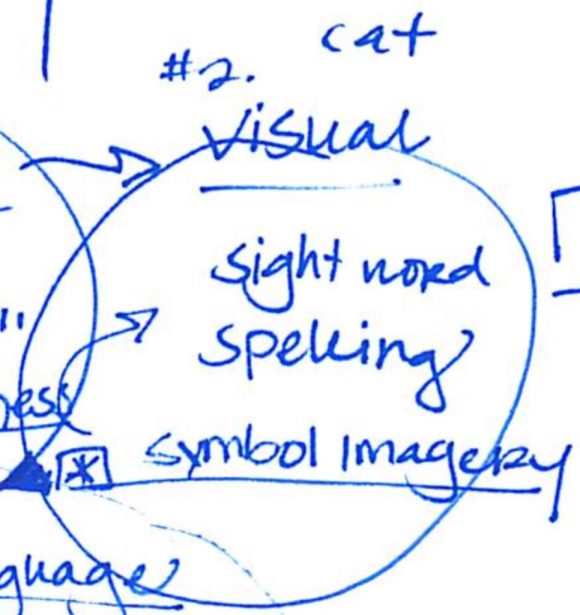
Reading is a complex cognition that is difficult to diagnose if the specialist doesn’t understand the current neuroscience of it. QEEG and evoke potentials can reveal the neurophysiological damage that affects reading, and a comprehensive battery of objective tests can pinpoint the kinds of errors that need remediation.
Lindamood-Bell has the most robust reading evaluation I’ve come across. It’s broken down into Reading and Spelling; Vocabulary; Comprehension; Maths; and Combined Skills. Lindamood-Bell is a US company with locations around the world and online.
Reading and Spelling
- Phonemic Awareness (LAC-3): Perceive sounds in isolation and within words
- Informal Tests of Writing Identify Symbol to Sound relationships for 50 letters and spell nonsense words
- Symbol Imagery: Image and manipulate orthographic and phonemic patterns
- Word Attack (WRMT-R): Read a list of progressively difficult nonsense words
- Word Recognition (SORT-R3): Read a list of progressively difficult real words
- Spelling (WRAT-4): Spell a list of progressively difficult real words
- †Paragraph Reading Rate, Accuracy
- Fluency (GORT, GORT-4)
Vocabulary
- Vocabulary (PPVT-4): Select one picture from four that matches a spoken word
- Word Opposites (DTLA-4 or -A): Say the opposite of a verbally provided word
Comprehension
- †Verbal Absurdities (DTLA): Verbally express what is illogical about each anecdote
- †Following Directions (DTLA-2): Mark visual material after hearing spoken directions
- †Reading Recall (GORT): Answer open-ended questions after reading a paragraph aloud
- Paragraph Comprehension (GORT-4): Answer multiple-choice questions after reading a paragraph aloud
Maths
- Maths Computation (WRAT-4): Solve basic maths and algebra problems
- Maths Story Problems (TOMA-2): Read and solve simple to complex story problems that require computation
Combined Skills
- Writing (TOWL-3): Write a story about a picture
- Preschool Assessment (PLAI-2): Answer a variety of questions to assess preschool concepts (it would be interesting to see if this picked up issues in a person with severe damage to their reading and cognitions)
I wrote about the testing experience and the results at jeejeebhoy.ca.
Evaluation of Comprehension
As Lindamood-Bell conceives of reading, reading comprises decoding and comprehension. Decoding is done in the reading foundation. There are three parts to reading foundation: auditory, visual, and language.
This concept is what I tried to get across to specialist after specialist: just because I could read words and sentences didn’t mean I could comprehend them anymore after brain injury.
“. . . thinking that reading is decoding a word but reading is being able to comprehend.” Nanci Bell
Auditory
The ability to hear phonemes, the sound parts that make up words.

Visual
The ability to recognize and pronounce high-frequency words. The ability to spell high-frequency words, that is, words that are used often in everyday reading. And the ability to image symbols, that is, letters or letter combinations.

Language
Vocabulary. And the ability to figure out an unknown word within the context of known words.

Encompassing these three foundations of reading is comprehension.
“If there’s weak comprehension, … frequently teachers and parents don’t really know perhaps there’s weak comprehension. . . . If it’s really severe could be labelled hyperlexia there’s a gap between ability to read words and ability to comprehend. Or if it’s weak enough, it can fall into the label of autism.” Nanci Bell
Comprehension

Lindamood-Bell uses Dual Coding Theory to explain how what we decode while reading — either text or listening to the words — is turned into comprehension by our brains. In dual coding theory, the symbols — words on text or words heard by the ears — the auditory, visual, and language parts of reading — are turned into non-verbal concepts that we can picture. A painting represents a thousand words and all. (Wikipedia notes it was a Canadian who posited this theory.)

As part of that theory, they posit that concept imagery is how we understand what we’re reading. When we read or listen, we create a picture in our mind of what we’re seeing or hearing.

Nanci Bell, co-founder of Lindamood-Bell, explains comprehension and concept imagery in the video below. Note that what we often think of as reading issues, for example, dyslexia, occurs on the decoding side of the ledger. The comprehension side isn’t usually talked about. It usually doesn’t even have labels like the decoding side does. I personally don’t think labels are always useful, but in our current milieu where everything is labelled, a label gives credibility. I think that’s why when people with brain injury say they have trouble reading yet can read words and use some or a lot of their vocabulary, specialists, family, and friends don’t believe them. But as Bell says, vocabulary is not comprehension.
Last Words
If your clinic or rehabilitation doesn’t include these tests, especially the ones under Comprehension, you’re not likely to receive an accurate evaluation nor will your therapist or you know what specifically needs to be treated and how to treat it. Pinpointing the specific difficulties — going beyond the descriptor of “you can’t read” — and explaining the current neuroscientific understanding, will lead to effective treatments that restore book reading. Reading is too important for pleasure, for stress relief, and for working in today’s world, to be left undiagnosed and untreated.
See my blog posts on my website to see what a thorough reading evaluation is like and the kinds of information you’ll be given. To learn what it’s like losing the ability to read after brain injury and not receive any treatment, check out my Psychology Today articles on the grief of reading loss, the lack of cognitive empathy for this profound loss, the failure versus the success of traditional versus using effective reading therapies, Or pick up a copy of Concussion Is Brain Injury: Treating the Neurons and Me.
† Measure administered for instructional planning purposes only